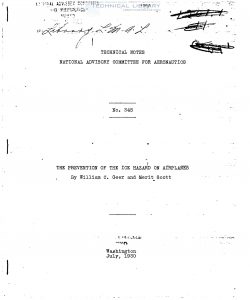naca-tn-345
- Version
- 160 Downloads
- 1.18 MB File Size
- 1 File Count
- November 24, 2016 Create Date
- November 24, 2016 Last Updated
National Advisory Committee for Aeronautics, Technical Notes - The Prevention of the Ice Hazard on Airplanes

In order to obtain an intimate picture of the Way in which
ice is formed on an aerodynamic form due to droplets in the at—
mosphere, let the case of a strut with the flow lines be held in
mind (See Fig. 1). A droplet is imagined to approach the strut
coming down one of the tubes of flow. The forces which act upon
the drop are the folloWing: (l) a force arising from the pres— “
sure gradient normal to the lines of flow; (2) a viscous force
due to the air which tends to drag the drop along with it. As
the drop approaches the strut force (1) tends to hold the drop
away from the surface, where the curvature of the tube is con,
vex toward the strut, and to force it on where the cuIVature is
concave toward the strut; while force (2) tends to constrain it
to a tube of flow and hence to carry it by without deposition.
An examination of these forces shows that the smaller drops
are accelerated from the stagnant point IS (See Fig. 1) much
faster than the larger drops. The result, therefore, is a sepaé
ration of the drops according to size, the smaller ones being
carried farther from S. As Figure 3 indicates, actual former
tions under suitable conditions show a solid hard cap symmetric—
ally located over S with a'scattering of crystalline rime at
its borders which appears very much like little prisms standing
up into the wind. Such deposits hare been obtained many times
at the leading edge of wings and struts upon airplanes in flight
as well as upon the strut sections in the wind tunnel as will
be referred to later.
As these fine water droplets strike the moving airplane
they are deposited upon it, forming ice. Since at the time of
contact, the water is liquid, it naturally tends to fill up all
the small irregularities of the surface with which it is in con—
tact and clings to it with a degree of adhesion that is natural
to the adhesion of ice to the particular solid. The reasons for
high adhesion of the ice to the'exposed parts of the airplane,
are probably (a) the solubility of water in these substances
which.when frozen is anchored in them; (b) the action of the
force known as adsorption, assuming this to be a purely inter—
facial force existing between any two substances; and (c) the
specific interfacial adhesion tension which may be peculiar to
two different substances.
| File | Action |
|---|---|
| naca-tn-345 The Prevention of the Ice Hazard on Airplanes.pdf | Download |
Comment On This Post